Optimal Disposal Options for Derelict Ships and Boats: A Study
VerifiedAdded on 2022/09/22
|9
|2909
|30
Report
AI Summary
This report investigates the most effective methods for disposing of derelict ships and boats, emphasizing the need for sustainable practices to mitigate environmental damage. It examines various options, including recycling materials for construction and automotive industries, which could reduce manufacturing costs and resource consumption. The study also explores the feasibility of using recycled materials and developing artificial reefs with large boats, highlighting both the potential benefits, such as habitat creation and coastal erosion prevention, and the associated risks, like pollution and disruption of marine ecosystems. The report identifies research gaps, particularly in the long-term environmental and economic impacts of different disposal methods, and proposes questions for further investigation, such as the optimal recycling techniques and the feasibility of using recycled materials in various sectors. The conclusion stresses the importance of reusing derelict ship materials to address environmental and economic concerns.
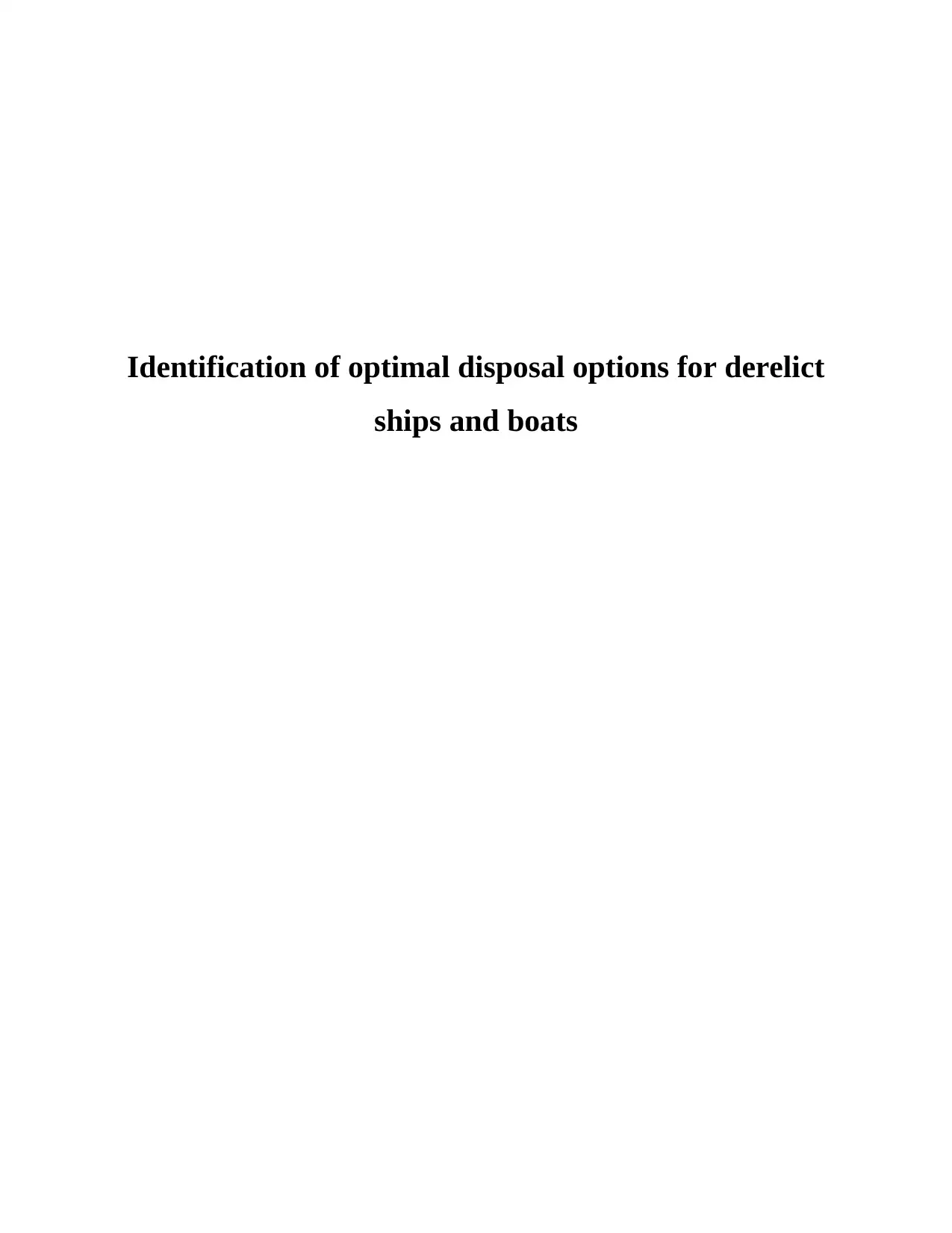
Identification of optimal disposal options for derelict
ships and boats
ships and boats
Paraphrase This Document
Need a fresh take? Get an instant paraphrase of this document with our AI Paraphraser
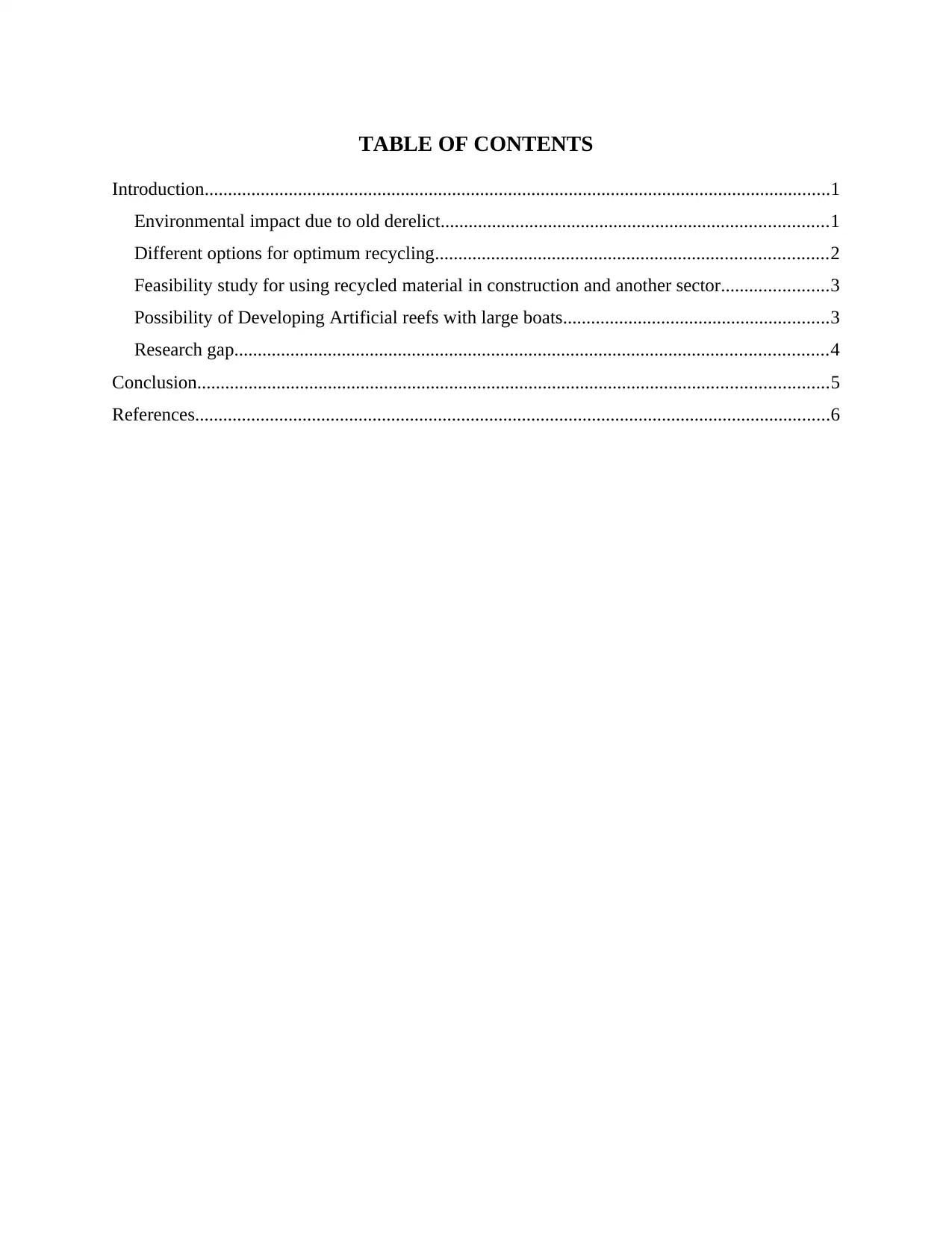
TABLE OF CONTENTS
Introduction......................................................................................................................................1
Environmental impact due to old derelict...................................................................................1
Different options for optimum recycling....................................................................................2
Feasibility study for using recycled material in construction and another sector.......................3
Possibility of Developing Artificial reefs with large boats.........................................................3
Research gap...............................................................................................................................4
Conclusion.......................................................................................................................................5
References........................................................................................................................................6
Introduction......................................................................................................................................1
Environmental impact due to old derelict...................................................................................1
Different options for optimum recycling....................................................................................2
Feasibility study for using recycled material in construction and another sector.......................3
Possibility of Developing Artificial reefs with large boats.........................................................3
Research gap...............................................................................................................................4
Conclusion.......................................................................................................................................5
References........................................................................................................................................6
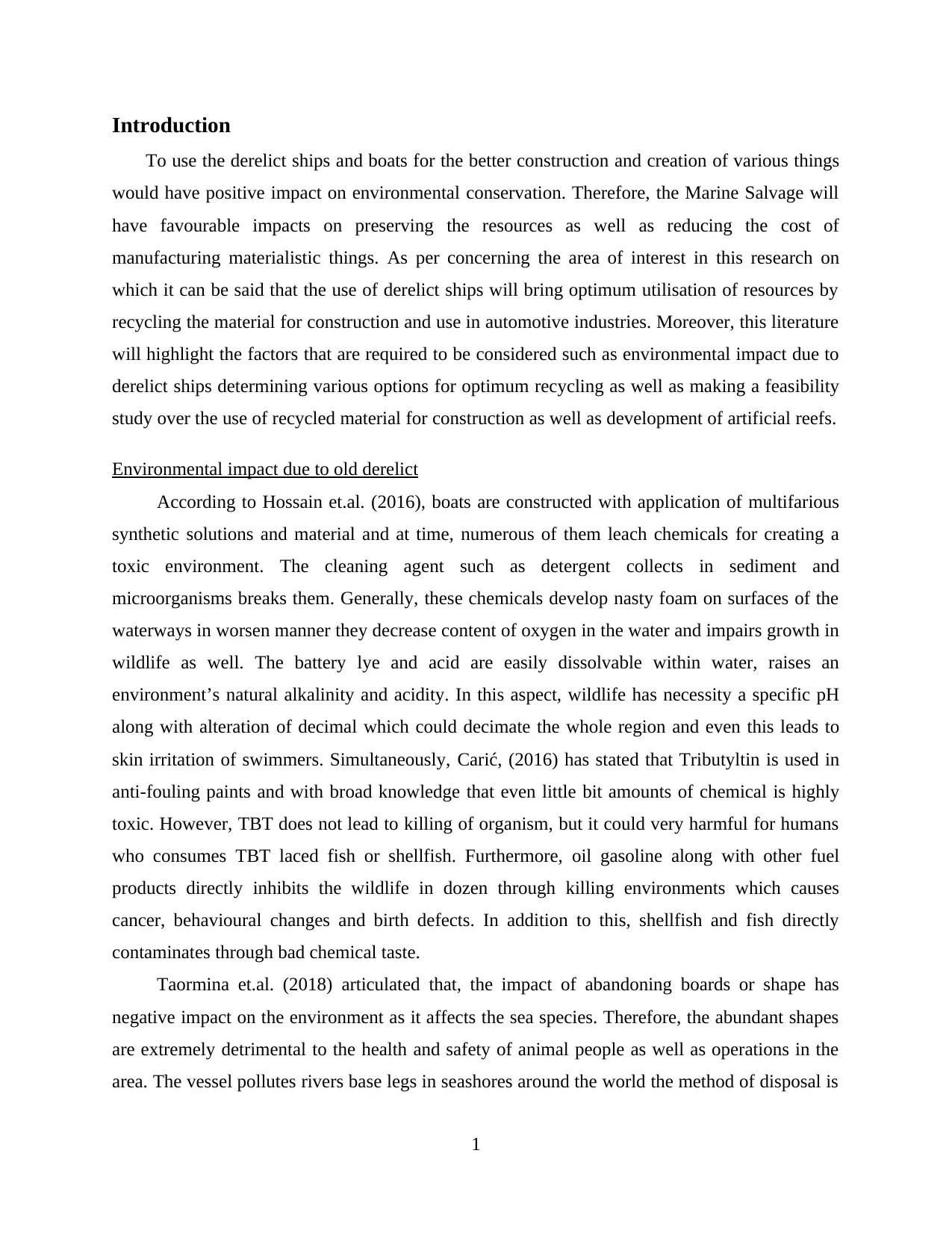
Introduction
To use the derelict ships and boats for the better construction and creation of various things
would have positive impact on environmental conservation. Therefore, the Marine Salvage will
have favourable impacts on preserving the resources as well as reducing the cost of
manufacturing materialistic things. As per concerning the area of interest in this research on
which it can be said that the use of derelict ships will bring optimum utilisation of resources by
recycling the material for construction and use in automotive industries. Moreover, this literature
will highlight the factors that are required to be considered such as environmental impact due to
derelict ships determining various options for optimum recycling as well as making a feasibility
study over the use of recycled material for construction as well as development of artificial reefs.
Environmental impact due to old derelict
According to Hossain et.al. (2016), boats are constructed with application of multifarious
synthetic solutions and material and at time, numerous of them leach chemicals for creating a
toxic environment. The cleaning agent such as detergent collects in sediment and
microorganisms breaks them. Generally, these chemicals develop nasty foam on surfaces of the
waterways in worsen manner they decrease content of oxygen in the water and impairs growth in
wildlife as well. The battery lye and acid are easily dissolvable within water, raises an
environment’s natural alkalinity and acidity. In this aspect, wildlife has necessity a specific pH
along with alteration of decimal which could decimate the whole region and even this leads to
skin irritation of swimmers. Simultaneously, Carić, (2016) has stated that Tributyltin is used in
anti-fouling paints and with broad knowledge that even little bit amounts of chemical is highly
toxic. However, TBT does not lead to killing of organism, but it could very harmful for humans
who consumes TBT laced fish or shellfish. Furthermore, oil gasoline along with other fuel
products directly inhibits the wildlife in dozen through killing environments which causes
cancer, behavioural changes and birth defects. In addition to this, shellfish and fish directly
contaminates through bad chemical taste.
Taormina et.al. (2018) articulated that, the impact of abandoning boards or shape has
negative impact on the environment as it affects the sea species. Therefore, the abundant shapes
are extremely detrimental to the health and safety of animal people as well as operations in the
area. The vessel pollutes rivers base legs in seashores around the world the method of disposal is
1
To use the derelict ships and boats for the better construction and creation of various things
would have positive impact on environmental conservation. Therefore, the Marine Salvage will
have favourable impacts on preserving the resources as well as reducing the cost of
manufacturing materialistic things. As per concerning the area of interest in this research on
which it can be said that the use of derelict ships will bring optimum utilisation of resources by
recycling the material for construction and use in automotive industries. Moreover, this literature
will highlight the factors that are required to be considered such as environmental impact due to
derelict ships determining various options for optimum recycling as well as making a feasibility
study over the use of recycled material for construction as well as development of artificial reefs.
Environmental impact due to old derelict
According to Hossain et.al. (2016), boats are constructed with application of multifarious
synthetic solutions and material and at time, numerous of them leach chemicals for creating a
toxic environment. The cleaning agent such as detergent collects in sediment and
microorganisms breaks them. Generally, these chemicals develop nasty foam on surfaces of the
waterways in worsen manner they decrease content of oxygen in the water and impairs growth in
wildlife as well. The battery lye and acid are easily dissolvable within water, raises an
environment’s natural alkalinity and acidity. In this aspect, wildlife has necessity a specific pH
along with alteration of decimal which could decimate the whole region and even this leads to
skin irritation of swimmers. Simultaneously, Carić, (2016) has stated that Tributyltin is used in
anti-fouling paints and with broad knowledge that even little bit amounts of chemical is highly
toxic. However, TBT does not lead to killing of organism, but it could very harmful for humans
who consumes TBT laced fish or shellfish. Furthermore, oil gasoline along with other fuel
products directly inhibits the wildlife in dozen through killing environments which causes
cancer, behavioural changes and birth defects. In addition to this, shellfish and fish directly
contaminates through bad chemical taste.
Taormina et.al. (2018) articulated that, the impact of abandoning boards or shape has
negative impact on the environment as it affects the sea species. Therefore, the abundant shapes
are extremely detrimental to the health and safety of animal people as well as operations in the
area. The vessel pollutes rivers base legs in seashores around the world the method of disposal is
1
⊘ This is a preview!⊘
Do you want full access?
Subscribe today to unlock all pages.

Trusted by 1+ million students worldwide
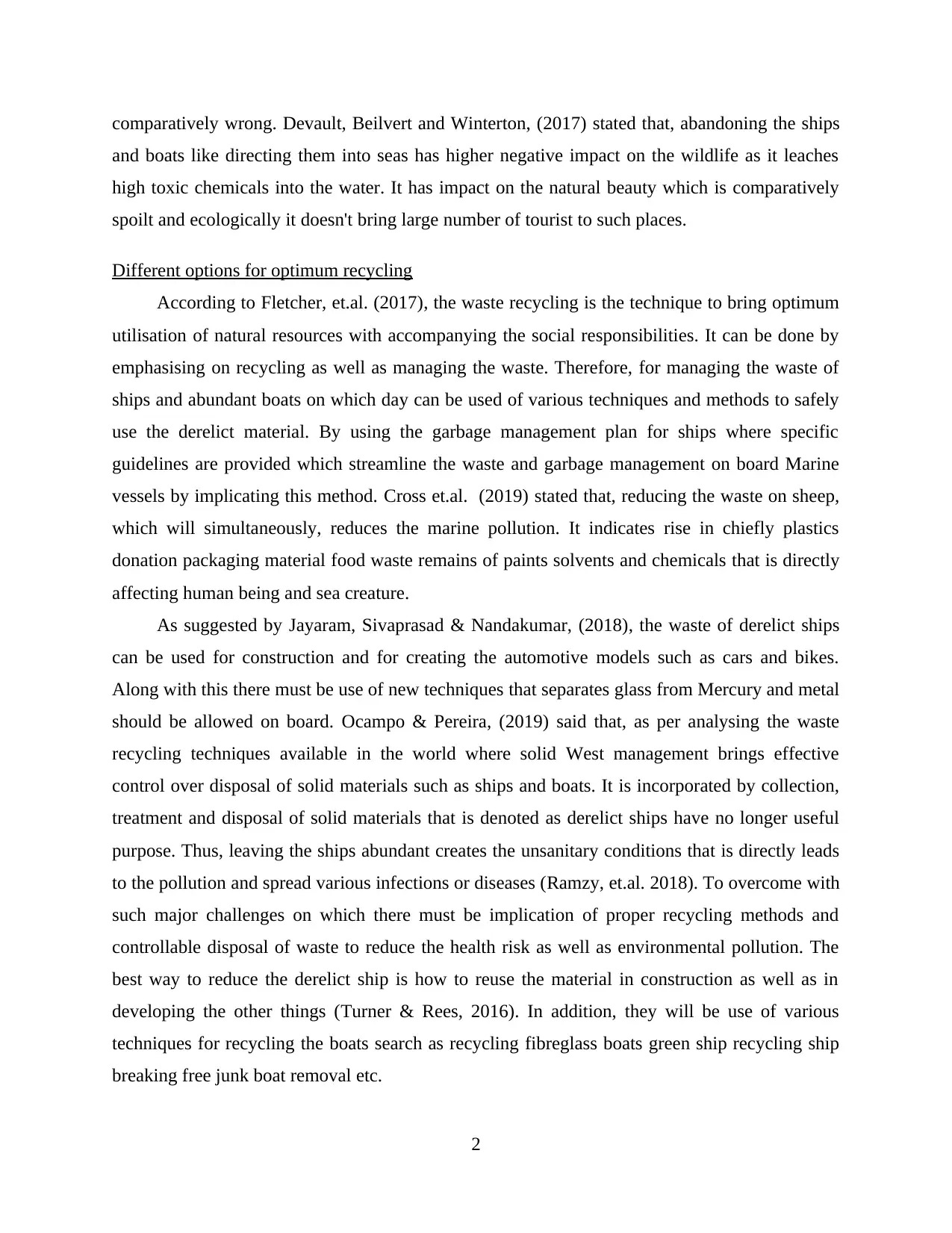
comparatively wrong. Devault, Beilvert and Winterton, (2017) stated that, abandoning the ships
and boats like directing them into seas has higher negative impact on the wildlife as it leaches
high toxic chemicals into the water. It has impact on the natural beauty which is comparatively
spoilt and ecologically it doesn't bring large number of tourist to such places.
Different options for optimum recycling
According to Fletcher, et.al. (2017), the waste recycling is the technique to bring optimum
utilisation of natural resources with accompanying the social responsibilities. It can be done by
emphasising on recycling as well as managing the waste. Therefore, for managing the waste of
ships and abundant boats on which day can be used of various techniques and methods to safely
use the derelict material. By using the garbage management plan for ships where specific
guidelines are provided which streamline the waste and garbage management on board Marine
vessels by implicating this method. Cross et.al. (2019) stated that, reducing the waste on sheep,
which will simultaneously, reduces the marine pollution. It indicates rise in chiefly plastics
donation packaging material food waste remains of paints solvents and chemicals that is directly
affecting human being and sea creature.
As suggested by Jayaram, Sivaprasad & Nandakumar, (2018), the waste of derelict ships
can be used for construction and for creating the automotive models such as cars and bikes.
Along with this there must be use of new techniques that separates glass from Mercury and metal
should be allowed on board. Ocampo & Pereira, (2019) said that, as per analysing the waste
recycling techniques available in the world where solid West management brings effective
control over disposal of solid materials such as ships and boats. It is incorporated by collection,
treatment and disposal of solid materials that is denoted as derelict ships have no longer useful
purpose. Thus, leaving the ships abundant creates the unsanitary conditions that is directly leads
to the pollution and spread various infections or diseases (Ramzy, et.al. 2018). To overcome with
such major challenges on which there must be implication of proper recycling methods and
controllable disposal of waste to reduce the health risk as well as environmental pollution. The
best way to reduce the derelict ship is how to reuse the material in construction as well as in
developing the other things (Turner & Rees, 2016). In addition, they will be use of various
techniques for recycling the boats search as recycling fibreglass boats green ship recycling ship
breaking free junk boat removal etc.
2
and boats like directing them into seas has higher negative impact on the wildlife as it leaches
high toxic chemicals into the water. It has impact on the natural beauty which is comparatively
spoilt and ecologically it doesn't bring large number of tourist to such places.
Different options for optimum recycling
According to Fletcher, et.al. (2017), the waste recycling is the technique to bring optimum
utilisation of natural resources with accompanying the social responsibilities. It can be done by
emphasising on recycling as well as managing the waste. Therefore, for managing the waste of
ships and abundant boats on which day can be used of various techniques and methods to safely
use the derelict material. By using the garbage management plan for ships where specific
guidelines are provided which streamline the waste and garbage management on board Marine
vessels by implicating this method. Cross et.al. (2019) stated that, reducing the waste on sheep,
which will simultaneously, reduces the marine pollution. It indicates rise in chiefly plastics
donation packaging material food waste remains of paints solvents and chemicals that is directly
affecting human being and sea creature.
As suggested by Jayaram, Sivaprasad & Nandakumar, (2018), the waste of derelict ships
can be used for construction and for creating the automotive models such as cars and bikes.
Along with this there must be use of new techniques that separates glass from Mercury and metal
should be allowed on board. Ocampo & Pereira, (2019) said that, as per analysing the waste
recycling techniques available in the world where solid West management brings effective
control over disposal of solid materials such as ships and boats. It is incorporated by collection,
treatment and disposal of solid materials that is denoted as derelict ships have no longer useful
purpose. Thus, leaving the ships abundant creates the unsanitary conditions that is directly leads
to the pollution and spread various infections or diseases (Ramzy, et.al. 2018). To overcome with
such major challenges on which there must be implication of proper recycling methods and
controllable disposal of waste to reduce the health risk as well as environmental pollution. The
best way to reduce the derelict ship is how to reuse the material in construction as well as in
developing the other things (Turner & Rees, 2016). In addition, they will be use of various
techniques for recycling the boats search as recycling fibreglass boats green ship recycling ship
breaking free junk boat removal etc.
2
Paraphrase This Document
Need a fresh take? Get an instant paraphrase of this document with our AI Paraphraser
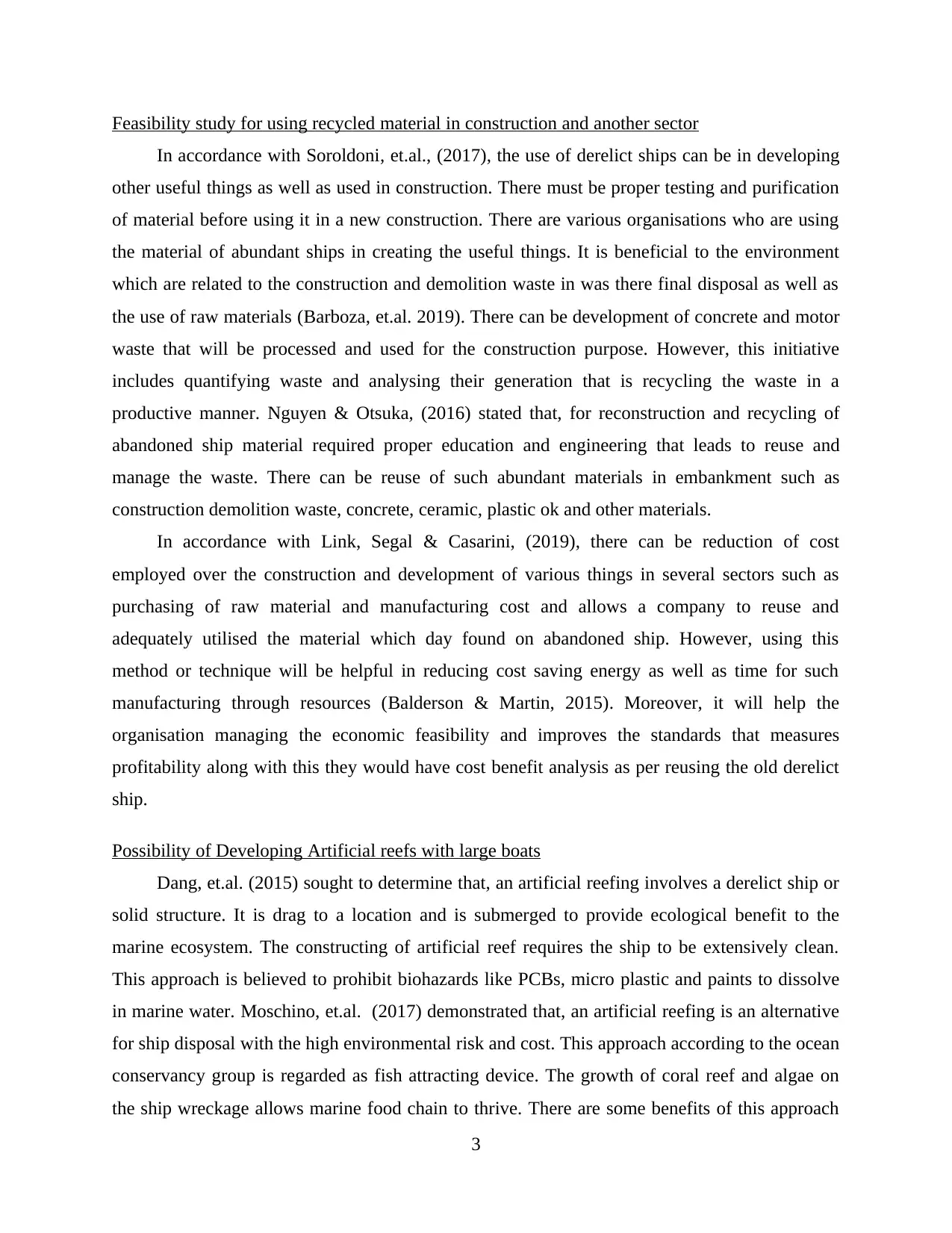
Feasibility study for using recycled material in construction and another sector
In accordance with Soroldoni, et.al., (2017), the use of derelict ships can be in developing
other useful things as well as used in construction. There must be proper testing and purification
of material before using it in a new construction. There are various organisations who are using
the material of abundant ships in creating the useful things. It is beneficial to the environment
which are related to the construction and demolition waste in was there final disposal as well as
the use of raw materials (Barboza, et.al. 2019). There can be development of concrete and motor
waste that will be processed and used for the construction purpose. However, this initiative
includes quantifying waste and analysing their generation that is recycling the waste in a
productive manner. Nguyen & Otsuka, (2016) stated that, for reconstruction and recycling of
abandoned ship material required proper education and engineering that leads to reuse and
manage the waste. There can be reuse of such abundant materials in embankment such as
construction demolition waste, concrete, ceramic, plastic ok and other materials.
In accordance with Link, Segal & Casarini, (2019), there can be reduction of cost
employed over the construction and development of various things in several sectors such as
purchasing of raw material and manufacturing cost and allows a company to reuse and
adequately utilised the material which day found on abandoned ship. However, using this
method or technique will be helpful in reducing cost saving energy as well as time for such
manufacturing through resources (Balderson & Martin, 2015). Moreover, it will help the
organisation managing the economic feasibility and improves the standards that measures
profitability along with this they would have cost benefit analysis as per reusing the old derelict
ship.
Possibility of Developing Artificial reefs with large boats
Dang, et.al. (2015) sought to determine that, an artificial reefing involves a derelict ship or
solid structure. It is drag to a location and is submerged to provide ecological benefit to the
marine ecosystem. The constructing of artificial reef requires the ship to be extensively clean.
This approach is believed to prohibit biohazards like PCBs, micro plastic and paints to dissolve
in marine water. Moschino, et.al. (2017) demonstrated that, an artificial reefing is an alternative
for ship disposal with the high environmental risk and cost. This approach according to the ocean
conservancy group is regarded as fish attracting device. The growth of coral reef and algae on
the ship wreckage allows marine food chain to thrive. There are some benefits of this approach
3
In accordance with Soroldoni, et.al., (2017), the use of derelict ships can be in developing
other useful things as well as used in construction. There must be proper testing and purification
of material before using it in a new construction. There are various organisations who are using
the material of abundant ships in creating the useful things. It is beneficial to the environment
which are related to the construction and demolition waste in was there final disposal as well as
the use of raw materials (Barboza, et.al. 2019). There can be development of concrete and motor
waste that will be processed and used for the construction purpose. However, this initiative
includes quantifying waste and analysing their generation that is recycling the waste in a
productive manner. Nguyen & Otsuka, (2016) stated that, for reconstruction and recycling of
abandoned ship material required proper education and engineering that leads to reuse and
manage the waste. There can be reuse of such abundant materials in embankment such as
construction demolition waste, concrete, ceramic, plastic ok and other materials.
In accordance with Link, Segal & Casarini, (2019), there can be reduction of cost
employed over the construction and development of various things in several sectors such as
purchasing of raw material and manufacturing cost and allows a company to reuse and
adequately utilised the material which day found on abandoned ship. However, using this
method or technique will be helpful in reducing cost saving energy as well as time for such
manufacturing through resources (Balderson & Martin, 2015). Moreover, it will help the
organisation managing the economic feasibility and improves the standards that measures
profitability along with this they would have cost benefit analysis as per reusing the old derelict
ship.
Possibility of Developing Artificial reefs with large boats
Dang, et.al. (2015) sought to determine that, an artificial reefing involves a derelict ship or
solid structure. It is drag to a location and is submerged to provide ecological benefit to the
marine ecosystem. The constructing of artificial reef requires the ship to be extensively clean.
This approach is believed to prohibit biohazards like PCBs, micro plastic and paints to dissolve
in marine water. Moschino, et.al. (2017) demonstrated that, an artificial reefing is an alternative
for ship disposal with the high environmental risk and cost. This approach according to the ocean
conservancy group is regarded as fish attracting device. The growth of coral reef and algae on
the ship wreckage allows marine food chain to thrive. There are some benefits of this approach
3
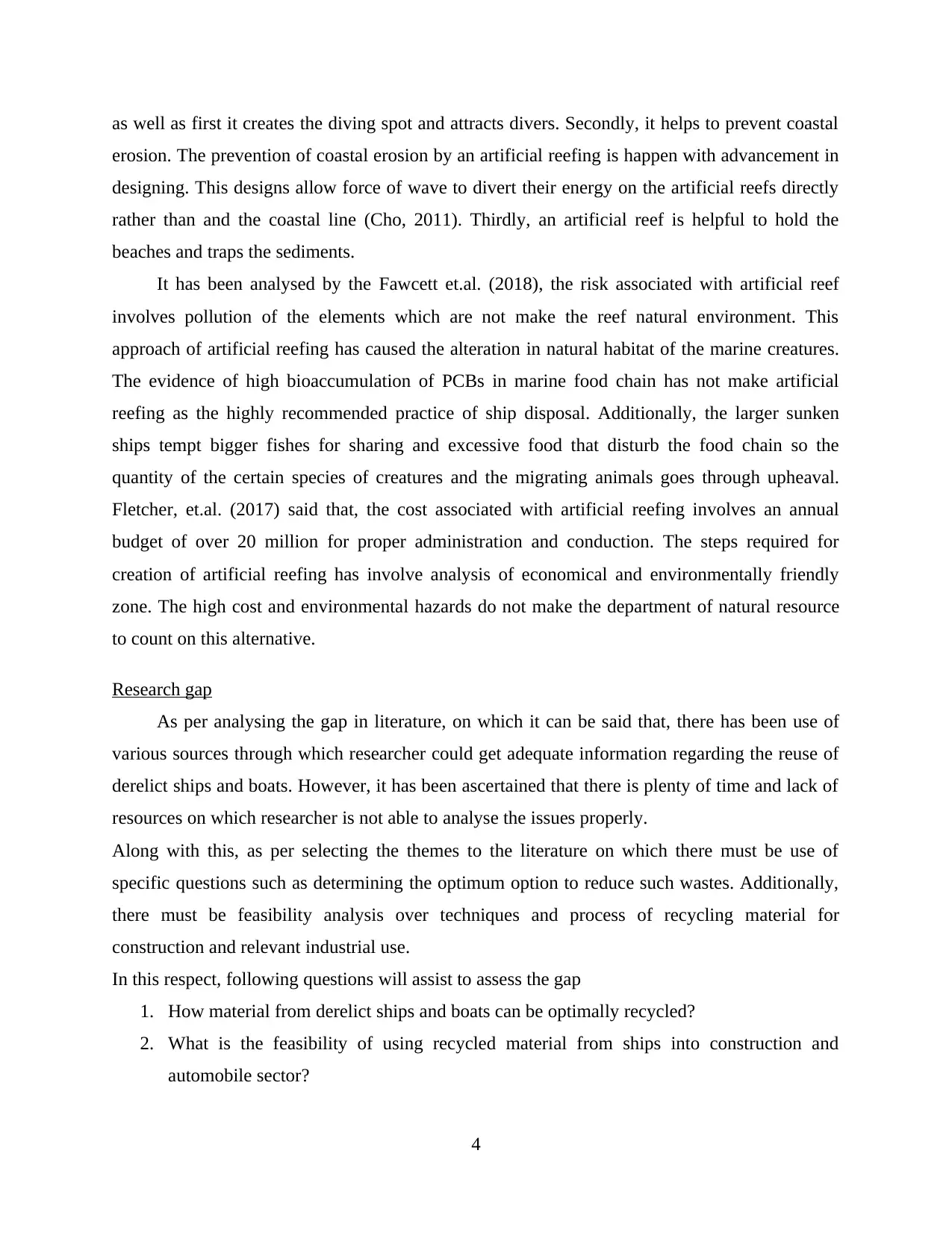
as well as first it creates the diving spot and attracts divers. Secondly, it helps to prevent coastal
erosion. The prevention of coastal erosion by an artificial reefing is happen with advancement in
designing. This designs allow force of wave to divert their energy on the artificial reefs directly
rather than and the coastal line (Cho, 2011). Thirdly, an artificial reef is helpful to hold the
beaches and traps the sediments.
It has been analysed by the Fawcett et.al. (2018), the risk associated with artificial reef
involves pollution of the elements which are not make the reef natural environment. This
approach of artificial reefing has caused the alteration in natural habitat of the marine creatures.
The evidence of high bioaccumulation of PCBs in marine food chain has not make artificial
reefing as the highly recommended practice of ship disposal. Additionally, the larger sunken
ships tempt bigger fishes for sharing and excessive food that disturb the food chain so the
quantity of the certain species of creatures and the migrating animals goes through upheaval.
Fletcher, et.al. (2017) said that, the cost associated with artificial reefing involves an annual
budget of over 20 million for proper administration and conduction. The steps required for
creation of artificial reefing has involve analysis of economical and environmentally friendly
zone. The high cost and environmental hazards do not make the department of natural resource
to count on this alternative.
Research gap
As per analysing the gap in literature, on which it can be said that, there has been use of
various sources through which researcher could get adequate information regarding the reuse of
derelict ships and boats. However, it has been ascertained that there is plenty of time and lack of
resources on which researcher is not able to analyse the issues properly.
Along with this, as per selecting the themes to the literature on which there must be use of
specific questions such as determining the optimum option to reduce such wastes. Additionally,
there must be feasibility analysis over techniques and process of recycling material for
construction and relevant industrial use.
In this respect, following questions will assist to assess the gap
1. How material from derelict ships and boats can be optimally recycled?
2. What is the feasibility of using recycled material from ships into construction and
automobile sector?
4
erosion. The prevention of coastal erosion by an artificial reefing is happen with advancement in
designing. This designs allow force of wave to divert their energy on the artificial reefs directly
rather than and the coastal line (Cho, 2011). Thirdly, an artificial reef is helpful to hold the
beaches and traps the sediments.
It has been analysed by the Fawcett et.al. (2018), the risk associated with artificial reef
involves pollution of the elements which are not make the reef natural environment. This
approach of artificial reefing has caused the alteration in natural habitat of the marine creatures.
The evidence of high bioaccumulation of PCBs in marine food chain has not make artificial
reefing as the highly recommended practice of ship disposal. Additionally, the larger sunken
ships tempt bigger fishes for sharing and excessive food that disturb the food chain so the
quantity of the certain species of creatures and the migrating animals goes through upheaval.
Fletcher, et.al. (2017) said that, the cost associated with artificial reefing involves an annual
budget of over 20 million for proper administration and conduction. The steps required for
creation of artificial reefing has involve analysis of economical and environmentally friendly
zone. The high cost and environmental hazards do not make the department of natural resource
to count on this alternative.
Research gap
As per analysing the gap in literature, on which it can be said that, there has been use of
various sources through which researcher could get adequate information regarding the reuse of
derelict ships and boats. However, it has been ascertained that there is plenty of time and lack of
resources on which researcher is not able to analyse the issues properly.
Along with this, as per selecting the themes to the literature on which there must be use of
specific questions such as determining the optimum option to reduce such wastes. Additionally,
there must be feasibility analysis over techniques and process of recycling material for
construction and relevant industrial use.
In this respect, following questions will assist to assess the gap
1. How material from derelict ships and boats can be optimally recycled?
2. What is the feasibility of using recycled material from ships into construction and
automobile sector?
4
⊘ This is a preview!⊘
Do you want full access?
Subscribe today to unlock all pages.

Trusted by 1+ million students worldwide
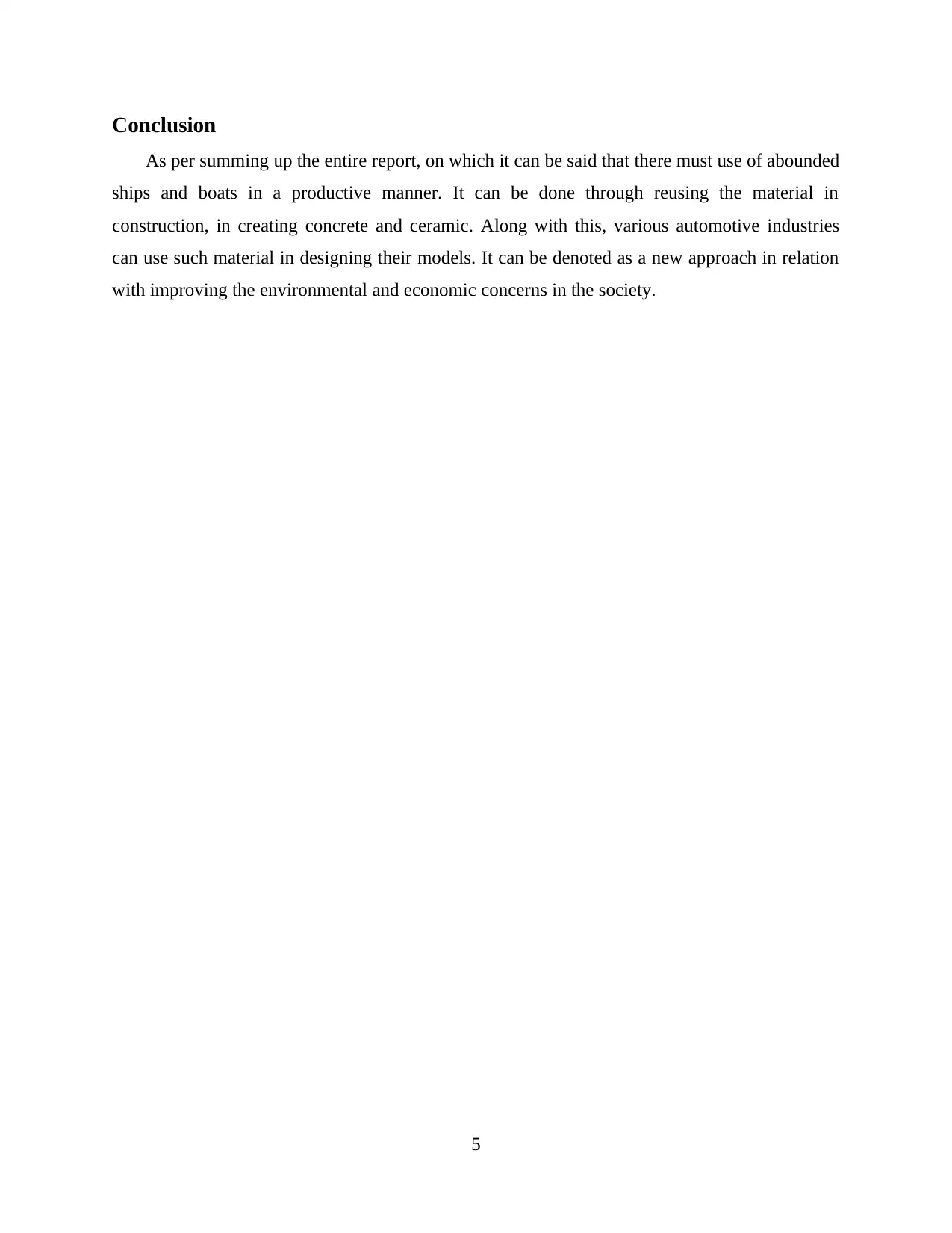
Conclusion
As per summing up the entire report, on which it can be said that there must use of abounded
ships and boats in a productive manner. It can be done through reusing the material in
construction, in creating concrete and ceramic. Along with this, various automotive industries
can use such material in designing their models. It can be denoted as a new approach in relation
with improving the environmental and economic concerns in the society.
5
As per summing up the entire report, on which it can be said that there must use of abounded
ships and boats in a productive manner. It can be done through reusing the material in
construction, in creating concrete and ceramic. Along with this, various automotive industries
can use such material in designing their models. It can be denoted as a new approach in relation
with improving the environmental and economic concerns in the society.
5
Paraphrase This Document
Need a fresh take? Get an instant paraphrase of this document with our AI Paraphraser
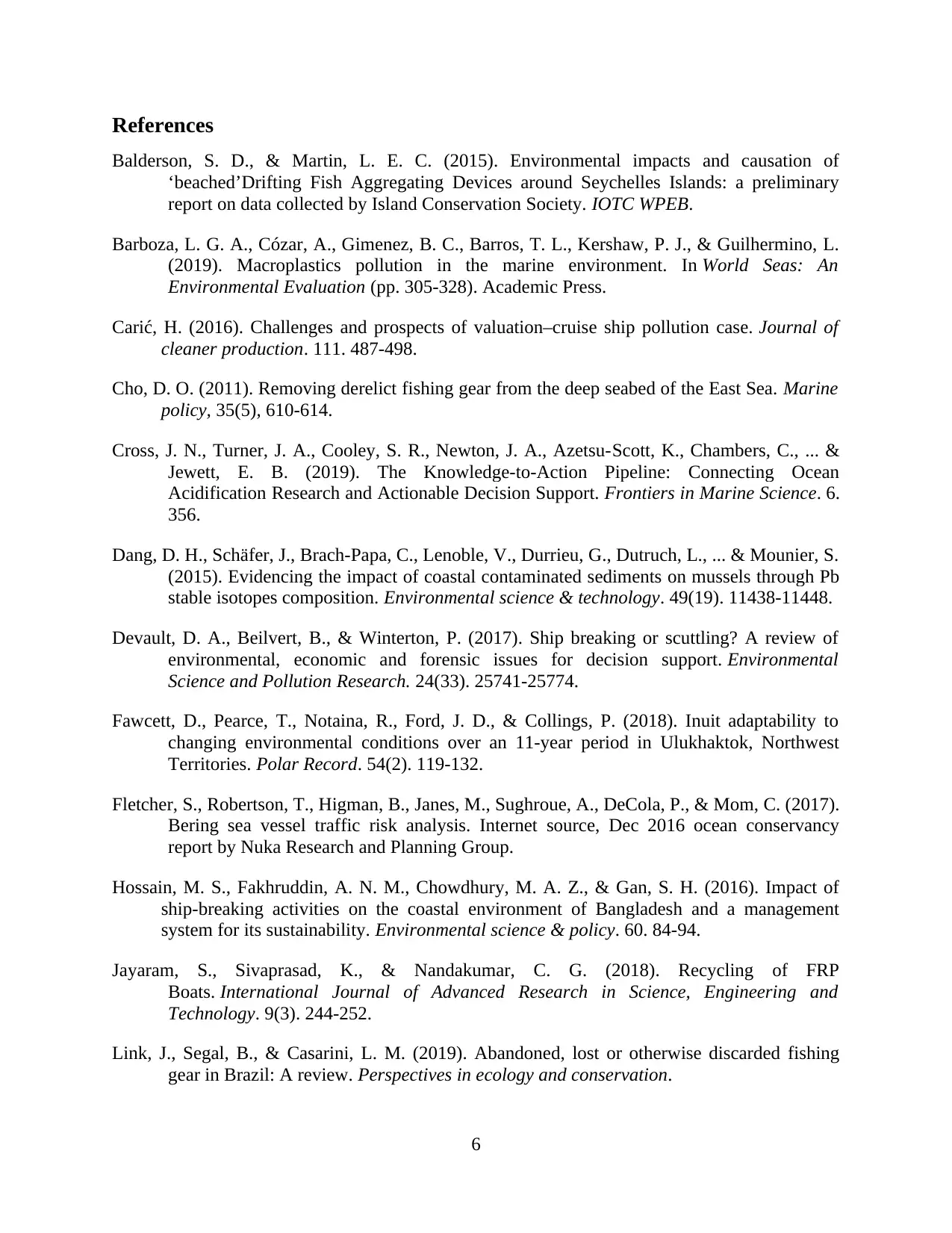
References
Balderson, S. D., & Martin, L. E. C. (2015). Environmental impacts and causation of
‘beached’Drifting Fish Aggregating Devices around Seychelles Islands: a preliminary
report on data collected by Island Conservation Society. IOTC WPEB.
Barboza, L. G. A., Cózar, A., Gimenez, B. C., Barros, T. L., Kershaw, P. J., & Guilhermino, L.
(2019). Macroplastics pollution in the marine environment. In World Seas: An
Environmental Evaluation (pp. 305-328). Academic Press.
Carić, H. (2016). Challenges and prospects of valuation–cruise ship pollution case. Journal of
cleaner production. 111. 487-498.
Cho, D. O. (2011). Removing derelict fishing gear from the deep seabed of the East Sea. Marine
policy, 35(5), 610-614.
Cross, J. N., Turner, J. A., Cooley, S. R., Newton, J. A., Azetsu-Scott, K., Chambers, C., ... &
Jewett, E. B. (2019). The Knowledge-to-Action Pipeline: Connecting Ocean
Acidification Research and Actionable Decision Support. Frontiers in Marine Science. 6.
356.
Dang, D. H., Schäfer, J., Brach-Papa, C., Lenoble, V., Durrieu, G., Dutruch, L., ... & Mounier, S.
(2015). Evidencing the impact of coastal contaminated sediments on mussels through Pb
stable isotopes composition. Environmental science & technology. 49(19). 11438-11448.
Devault, D. A., Beilvert, B., & Winterton, P. (2017). Ship breaking or scuttling? A review of
environmental, economic and forensic issues for decision support. Environmental
Science and Pollution Research. 24(33). 25741-25774.
Fawcett, D., Pearce, T., Notaina, R., Ford, J. D., & Collings, P. (2018). Inuit adaptability to
changing environmental conditions over an 11-year period in Ulukhaktok, Northwest
Territories. Polar Record. 54(2). 119-132.
Fletcher, S., Robertson, T., Higman, B., Janes, M., Sughroue, A., DeCola, P., & Mom, C. (2017).
Bering sea vessel traffic risk analysis. Internet source, Dec 2016 ocean conservancy
report by Nuka Research and Planning Group.
Hossain, M. S., Fakhruddin, A. N. M., Chowdhury, M. A. Z., & Gan, S. H. (2016). Impact of
ship-breaking activities on the coastal environment of Bangladesh and a management
system for its sustainability. Environmental science & policy. 60. 84-94.
Jayaram, S., Sivaprasad, K., & Nandakumar, C. G. (2018). Recycling of FRP
Boats. International Journal of Advanced Research in Science, Engineering and
Technology. 9(3). 244-252.
Link, J., Segal, B., & Casarini, L. M. (2019). Abandoned, lost or otherwise discarded fishing
gear in Brazil: A review. Perspectives in ecology and conservation.
6
Balderson, S. D., & Martin, L. E. C. (2015). Environmental impacts and causation of
‘beached’Drifting Fish Aggregating Devices around Seychelles Islands: a preliminary
report on data collected by Island Conservation Society. IOTC WPEB.
Barboza, L. G. A., Cózar, A., Gimenez, B. C., Barros, T. L., Kershaw, P. J., & Guilhermino, L.
(2019). Macroplastics pollution in the marine environment. In World Seas: An
Environmental Evaluation (pp. 305-328). Academic Press.
Carić, H. (2016). Challenges and prospects of valuation–cruise ship pollution case. Journal of
cleaner production. 111. 487-498.
Cho, D. O. (2011). Removing derelict fishing gear from the deep seabed of the East Sea. Marine
policy, 35(5), 610-614.
Cross, J. N., Turner, J. A., Cooley, S. R., Newton, J. A., Azetsu-Scott, K., Chambers, C., ... &
Jewett, E. B. (2019). The Knowledge-to-Action Pipeline: Connecting Ocean
Acidification Research and Actionable Decision Support. Frontiers in Marine Science. 6.
356.
Dang, D. H., Schäfer, J., Brach-Papa, C., Lenoble, V., Durrieu, G., Dutruch, L., ... & Mounier, S.
(2015). Evidencing the impact of coastal contaminated sediments on mussels through Pb
stable isotopes composition. Environmental science & technology. 49(19). 11438-11448.
Devault, D. A., Beilvert, B., & Winterton, P. (2017). Ship breaking or scuttling? A review of
environmental, economic and forensic issues for decision support. Environmental
Science and Pollution Research. 24(33). 25741-25774.
Fawcett, D., Pearce, T., Notaina, R., Ford, J. D., & Collings, P. (2018). Inuit adaptability to
changing environmental conditions over an 11-year period in Ulukhaktok, Northwest
Territories. Polar Record. 54(2). 119-132.
Fletcher, S., Robertson, T., Higman, B., Janes, M., Sughroue, A., DeCola, P., & Mom, C. (2017).
Bering sea vessel traffic risk analysis. Internet source, Dec 2016 ocean conservancy
report by Nuka Research and Planning Group.
Hossain, M. S., Fakhruddin, A. N. M., Chowdhury, M. A. Z., & Gan, S. H. (2016). Impact of
ship-breaking activities on the coastal environment of Bangladesh and a management
system for its sustainability. Environmental science & policy. 60. 84-94.
Jayaram, S., Sivaprasad, K., & Nandakumar, C. G. (2018). Recycling of FRP
Boats. International Journal of Advanced Research in Science, Engineering and
Technology. 9(3). 244-252.
Link, J., Segal, B., & Casarini, L. M. (2019). Abandoned, lost or otherwise discarded fishing
gear in Brazil: A review. Perspectives in ecology and conservation.
6
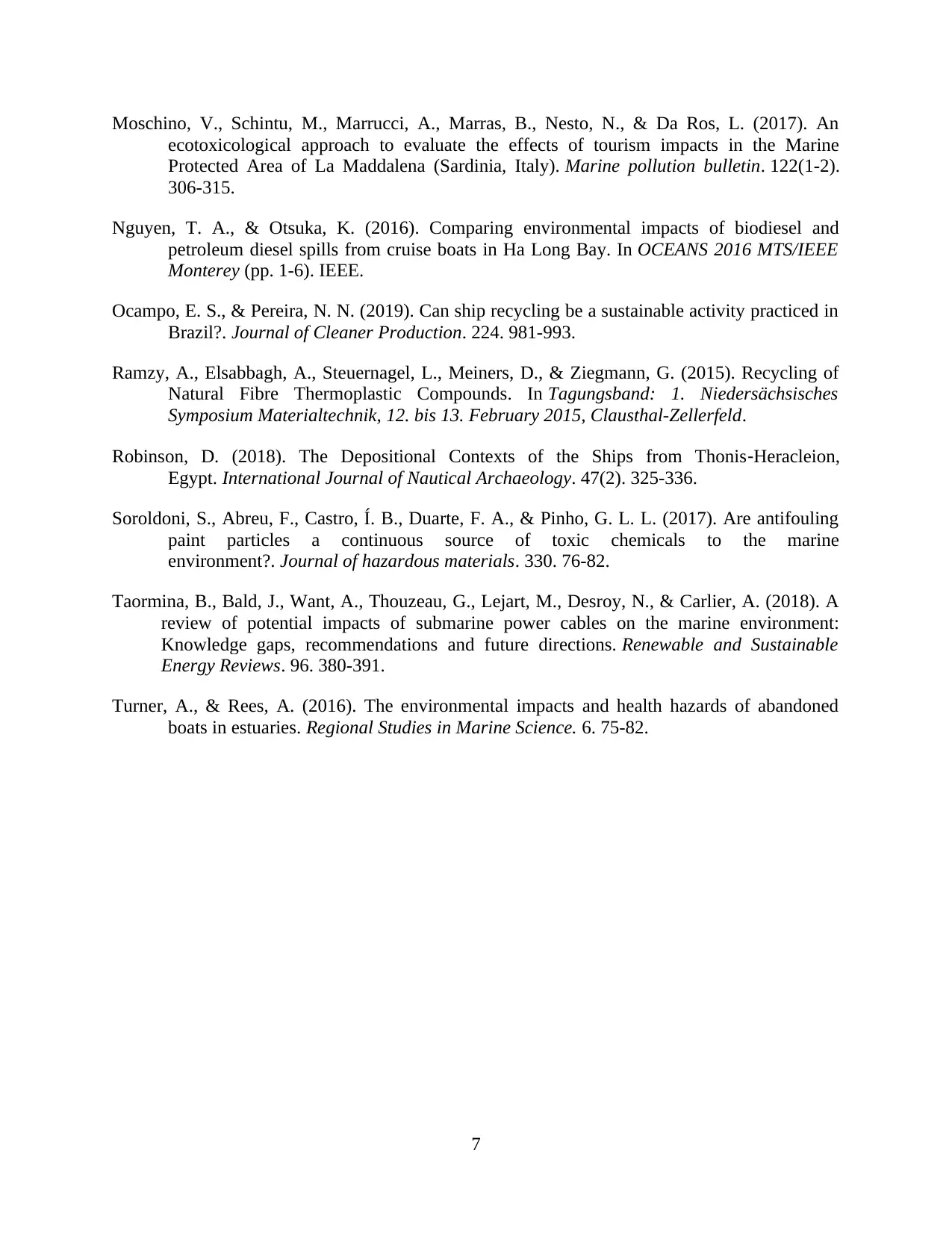
Moschino, V., Schintu, M., Marrucci, A., Marras, B., Nesto, N., & Da Ros, L. (2017). An
ecotoxicological approach to evaluate the effects of tourism impacts in the Marine
Protected Area of La Maddalena (Sardinia, Italy). Marine pollution bulletin. 122(1-2).
306-315.
Nguyen, T. A., & Otsuka, K. (2016). Comparing environmental impacts of biodiesel and
petroleum diesel spills from cruise boats in Ha Long Bay. In OCEANS 2016 MTS/IEEE
Monterey (pp. 1-6). IEEE.
Ocampo, E. S., & Pereira, N. N. (2019). Can ship recycling be a sustainable activity practiced in
Brazil?. Journal of Cleaner Production. 224. 981-993.
Ramzy, A., Elsabbagh, A., Steuernagel, L., Meiners, D., & Ziegmann, G. (2015). Recycling of
Natural Fibre Thermoplastic Compounds. In Tagungsband: 1. Niedersächsisches
Symposium Materialtechnik, 12. bis 13. February 2015, Clausthal-Zellerfeld.
Robinson, D. (2018). The Depositional Contexts of the Ships from Thonis‐Heracleion,
Egypt. International Journal of Nautical Archaeology. 47(2). 325-336.
Soroldoni, S., Abreu, F., Castro, Í. B., Duarte, F. A., & Pinho, G. L. L. (2017). Are antifouling
paint particles a continuous source of toxic chemicals to the marine
environment?. Journal of hazardous materials. 330. 76-82.
Taormina, B., Bald, J., Want, A., Thouzeau, G., Lejart, M., Desroy, N., & Carlier, A. (2018). A
review of potential impacts of submarine power cables on the marine environment:
Knowledge gaps, recommendations and future directions. Renewable and Sustainable
Energy Reviews. 96. 380-391.
Turner, A., & Rees, A. (2016). The environmental impacts and health hazards of abandoned
boats in estuaries. Regional Studies in Marine Science. 6. 75-82.
7
ecotoxicological approach to evaluate the effects of tourism impacts in the Marine
Protected Area of La Maddalena (Sardinia, Italy). Marine pollution bulletin. 122(1-2).
306-315.
Nguyen, T. A., & Otsuka, K. (2016). Comparing environmental impacts of biodiesel and
petroleum diesel spills from cruise boats in Ha Long Bay. In OCEANS 2016 MTS/IEEE
Monterey (pp. 1-6). IEEE.
Ocampo, E. S., & Pereira, N. N. (2019). Can ship recycling be a sustainable activity practiced in
Brazil?. Journal of Cleaner Production. 224. 981-993.
Ramzy, A., Elsabbagh, A., Steuernagel, L., Meiners, D., & Ziegmann, G. (2015). Recycling of
Natural Fibre Thermoplastic Compounds. In Tagungsband: 1. Niedersächsisches
Symposium Materialtechnik, 12. bis 13. February 2015, Clausthal-Zellerfeld.
Robinson, D. (2018). The Depositional Contexts of the Ships from Thonis‐Heracleion,
Egypt. International Journal of Nautical Archaeology. 47(2). 325-336.
Soroldoni, S., Abreu, F., Castro, Í. B., Duarte, F. A., & Pinho, G. L. L. (2017). Are antifouling
paint particles a continuous source of toxic chemicals to the marine
environment?. Journal of hazardous materials. 330. 76-82.
Taormina, B., Bald, J., Want, A., Thouzeau, G., Lejart, M., Desroy, N., & Carlier, A. (2018). A
review of potential impacts of submarine power cables on the marine environment:
Knowledge gaps, recommendations and future directions. Renewable and Sustainable
Energy Reviews. 96. 380-391.
Turner, A., & Rees, A. (2016). The environmental impacts and health hazards of abandoned
boats in estuaries. Regional Studies in Marine Science. 6. 75-82.
7
⊘ This is a preview!⊘
Do you want full access?
Subscribe today to unlock all pages.

Trusted by 1+ million students worldwide
1 out of 9
Your All-in-One AI-Powered Toolkit for Academic Success.
+13062052269
info@desklib.com
Available 24*7 on WhatsApp / Email
![[object Object]](/_next/static/media/star-bottom.7253800d.svg)
Unlock your academic potential
Copyright © 2020–2025 A2Z Services. All Rights Reserved. Developed and managed by ZUCOL.
